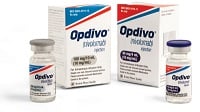 CHICAGO--The data on Bristol-Myers Squibb's ($BMY) hot new immunotherapy Opdivo kept rolling out Sunday at ASCO, showing that combining the drug with fellow Bristol cancer-fighter Yervoy proved more effective in treating advanced melanoma than Yervoy alone. But pairing up the two also increased the risk of side effects, which could offset the tandem's benefits for some patients.
CHICAGO--The data on Bristol-Myers Squibb's ($BMY) hot new immunotherapy Opdivo kept rolling out Sunday at ASCO, showing that combining the drug with fellow Bristol cancer-fighter Yervoy proved more effective in treating advanced melanoma than Yervoy alone. But pairing up the two also increased the risk of side effects, which could offset the tandem's benefits for some patients.
In a Phase III study of 945 patients with previously untreated, advanced melanoma, solo Opdivo more than doubled the average time to disease progression when compared with Yervoy, extending that period to 6.9 months from Yervoy's 2.9. And a cocktail of both drugs produced an even greater benefit, bringing that time to 11.5 months. Patients also posted substantially higher response rates when receiving the duo--57.6%--than the 19% they showed on Yervoy alone.
Lead study author Jedd Wolchok of Memorial Sloan Kettering Cancer Center said in a statement that investigators were "very encouraged" that the efficacy had held up in such a large trial. But the results weren't all rosy: The rate of serious drug-related side effects was highest in the combination arm at 55%, forcing 36% of patients in that group to halt therapy.
As such, the findings "warrant caution," Dr. Steven O'Day, director of The Los Angeles Skin Cancer Institute, said in a statement. "Physicians and patients will need to weigh these considerations carefully."
As for Bristol, it's hoping adding Opdivo to Yervoy can help Opdivo push forward in its market share battle with Merck's ($MRK) Keytruda. While Merck was the first of the two to notch an FDA approval in melanoma, Bristol followed not long after with its own speedy nod, and both companies are currently awaiting go-aheads in Europe.
Analysts, though, expect Opdivo to eventually come out on top sales-wise thanks to its promise in other cancers--including lung cancer, a lucrative field in which it leapfrogged Keytruda with a March green light. While melanoma represents a $3 billion opportunity for the PD-1/PD-L1 class, lung cancer's is vastly bigger, with industry-watchers predicting $21 billion in potential sales by 2022.
- here's the release
Special Reports: The 10 best-selling cancer drugs of 2013 | Top 20 orphan drugs by 2018 - Yervoy